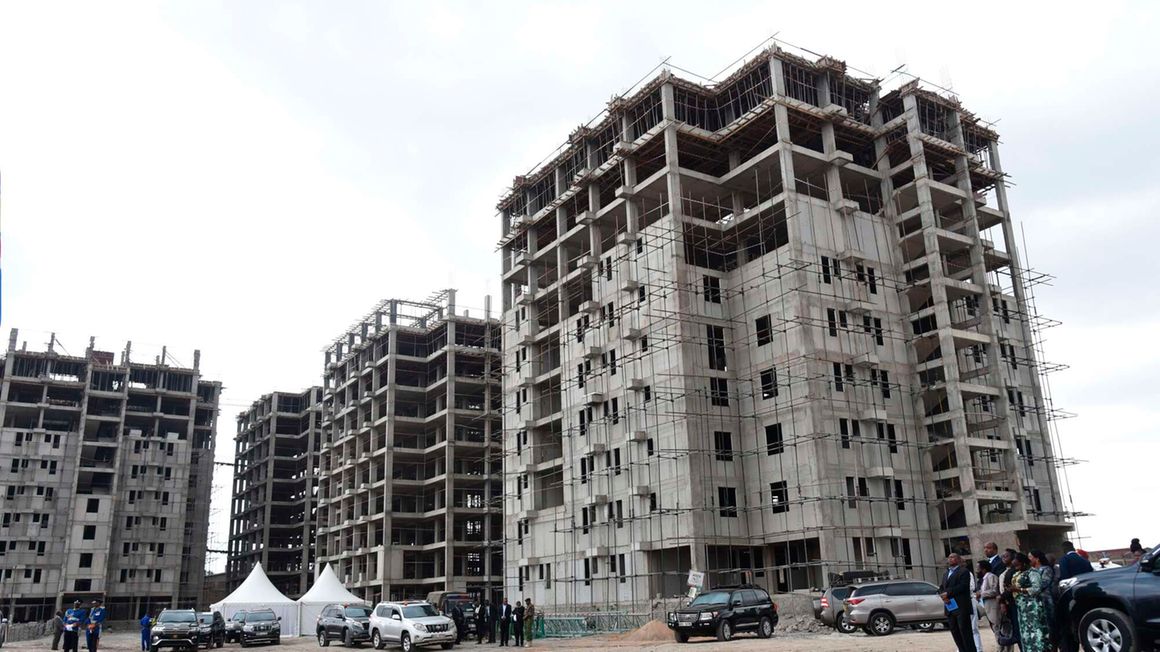
An ongoing affordable and social housing project at a former Metrological site in South b, Nairobi on October 3, 2022. PHOTO | EVANS HABIL | NMG
The right to housing is enshrined in Kenya’s Constitution under article 43 (1) (b), which stipulates that all citizens have the right to accessible and adequate homes, and to a reasonable standard of sanitation.
However, Kenya still grapples with a huge demand and housing supply gap.
We have an annual housing demand of 250,000 units with an estimated supply of 50,000 units, culminating in a housing deficit of two million units, or an 80 percent deficit.
A closer examination of the state of housing in the country shows that generally, the provision of housing is largely characterised by an inadequate supply of affordable and decent units, low urban home ownership and widespread informal housing.
Studies estimate that only two percent of the formally constructed houses target lower-income families, with about 65 percent of Kenya’s urban families having to cope with the informal settlements.
The Kenyan housing market faces a dynamic set of interrelated challenges; high cost of land, high cost of housing units, high incidental costs – stamp duty, legal fees etc, difficulty in property registration and limited access to long-term affordable finance.
Read: Affordable housing: A real shot at home ownership or hot air?
These challenges disproportionately affect low to moderate-income earners.
This notwithstanding affordable housing holds so much potential that when properly exploited can catapult the country’s economic growth and open up massive opportunities for employment.
Kenya has the capability to unlock affordable housing for the benefit of the country en masse.
A healthier population translates to a healthier economy
Housing is a key social determinant of people's health and overall quality of productivity.
It has a strong influence on a person’s mental and physical wellness; poverty has been proven to extremely hamper people’s options, which explains why it is closely interrelated with a range of acute and chronic health issues.
Further, exposure to other conditions such as poor sanitation and insecurity within the informal settlements shrinks people’s ability to work optimally and, in the process, their productivity levels plummet.
However, when people have access to quality affordable housing options, they are far less likely to face hazards associated with an informal settlement lifestyle.
Additionally, the cost incurred in the treatment of recurring health issues due to inadequate housing becomes disposable income and can be used for further self-economic empowerment.
Affordable housing investment spurs economic stimulus and job creation
Homeownership is a powerful engine for wealth creation and a means to enhance people’s livelihoods.
Investing in affordable housing, therefore, has been proven to create a multiplier effect, where direct and indirect benefits to the country include job creation, improved health and safety and increased household resilience.
Affordable housing for resilient intermediary cities
Kenya has been experiencing increasing urbanisation rates, with urban sprawling with new entrants at an estimated 3.4 percent annually, in search of better opportunities.
This accelerated urbanisation and the urban transition has encouraged stakeholders to collaborate and implement appropriate strategies to support affordable housing policies and their implementation in order to accommodate the ever-growing population.
As a result, we continue to witness new affordable housing developments in some of Kenya’s intermediary cities including Kisumu and Mombasa.
This has made the cities attractive enough to get international attention and thus, host global state-of-the-art conventions and as a result, contribute to the country’s revenue.
Promising future investment opportunities
Investing in affordable housing is an opportunity to decrease childhood poverty.
Giving children a better, reliable and more equitable path forward is one of the long-term ways to create generational wealth, build economic growth and foster healthier societies.
Equipping younger generations with tools for social mobility transcends beyond just a moral argument; it has also been proven to produce economic growth for communities.
Children who experience such empowerment while growing up are more likely to end up as successful and responsible citizens, who don’t hesitate to give back to their communities.
Read: Opportunities that are on offer under affordable housing
Ultimately, supporting affordable housing initiatives means investing in our communities' well-being. It would be prudent for all stakeholders across the supply chain in Kenya to dedicate themselves to the development of affordable housing.
The overarching objective should be to provide families with safe and stable housing because I believe homes are the foundation for everything in life.
KMRC provides affordable housing finance
The formal housing finance sector in Kenya is historically exclusionary and conservative. Most innovations have focused on short-term small-scale loans. But this is beginning to change.
The Kenya Mortgage Refinance Company (KMRC) was formed with the main purpose of providing long-term funds to primary mortgage lenders in order to make it possible for more people to own homes.
KMRC has come in to resolve one of the key challenges in the affordable housing market – the lack of affordable long-term finance.
It’s therefore addressing the long-term funding constraint hindering the growth of the mortgage market and reducing the cost of residential mortgages.
Johnson Oltetia is the CEO, Kenya Mortgage Refinance Company.




No comments :
Post a Comment